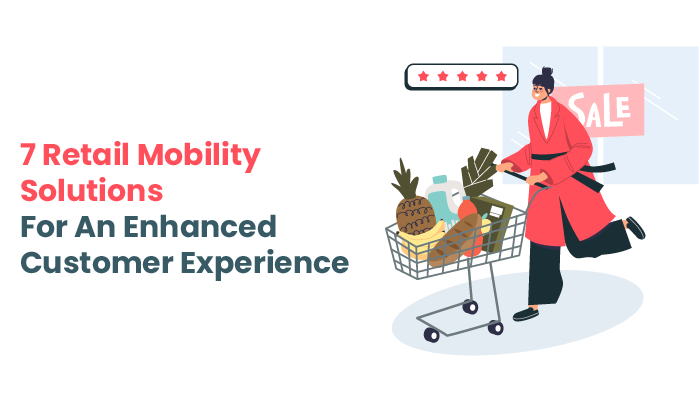The threshold of a successful retail experience keeps moving further each year with the penetration of constantly evolving technology. Retailers strive to provide the best shopping experience to customers by implementing the latest technologies to improve the in-store experience. Customers are now more inclined towards retailers providing more personalized experiences and instant services that are time effective and help in decision-making. With so much competition in the market, even the slightest bit of inconvenience can cause the retailer to lose a valuable customer.
Moreover, post-pandemic, there has also been a shift in customer behavior, creating a greater dependency on touchless experiences. More and more people are now opting for digital solutions to the traditional services that involve any human interaction. Even though there has been an increase in the e-commerce trades, studies reveal that many people still prefer retail, over online, as they can see and feel products in person. To stay ahead of the curve, retailers need to revamp the shopping experience for consumers to ensure customers’ safety and satisfaction. Retailers need to integrate solutions that ease the shopping experience, streamlines the logistics, automates operations, and helps customers navigate through the store seamlessly.
7 Retail Mobility Solutions to Enhance Customer Shopping Experience
1. POS Systems
The POS has come a long way, evolving from just a cash registering machine to a multifaceted computerized system that orchestrates an array of functions. With modern POS systems, retailers can manage accurate inventory records and report real-time sales. It can efficiently take care of employee management and track customer data for planning sales and promotions. Tracking customer purchase history can help integrate discounts, promotions, and giveaways automatically into their transaction. Retailers can improve their loyalty programs thus, increasing sales over time.
2. Omnichannel Experience
A recent Harvard Business Review survey of a massive 46,000 shoppers found that only 7% shopped exclusively online, 20% were store-only shoppers, while 73% moved across multiple channels. With the omnichannel strategy, businesses ensure that the sales channels work in harmony with the various marketing engagement points. By connecting the online, in-person, and mobile apps experiences together, customers can resume back to where they left off and continue with their shopping through their preferred channels.
3. Immersive product experience with QR Codes
QR codes are not just enabling easy contactless payments but also helping businesses enhance the customer experience in many other ways. Retailers can provide a unique experience to their customers using QR codes in the following cases. In clothing and fashion retail, racks and displays can have QR Codes that customers can scan to get more details on the collection and answer all their queries. Or in the food industry, customers can scan QR Codes to get the exact dates the food item was harvested, sourced, and delivered.
4.Augmented Reality (AR) App
AR-enabled store windows can pique interest in potential customers and act as magnets to get customers into the store. Large glass planes can act as mini AR catwalks when viewed on the Phone display using the AR app. Inside the store, consumers get a clear idea of the style and fit of the clothes they choose by simply holding the store app on the phone up to the sensor and viewing the AR models in different shapes and sizes appear on the screen wearing the clothes. It will enable customers to make quick decision making if to purchase or not, and they also wouldn’t need to try on the clothes physically before buying.
5. Price Checking
We often see in shops that the price tags have come off the products, have illegible writings on them, or are kept in the wrong price tagged rack. Due to the confusion, customers end up losing interest or moving past the aisle without buying anything. To avoid this, a mobile price scanner or digital price checking kiosks can prove very useful, making the shopping experience seamless. Customers can scan the codes and see the prices on the app instantly without having to look for the staff.
6. Self Check-Out
In times where virtual experiences are preferred more over physical encounters, self-checkouts come handy. A generation obsessed with conversation AI rather than human interaction, mobile self-checkout is an upgrade from conventional self-checkouts. With these apps, customers can scan the product’s UPS code on their mobile devices, add items to their cart and make payments on the app itself. Not only does this save time, but it is also a safer way to shop with lesser proximity with humans in long queues and contactless payments.
7. Smart Beacons & Custom Ads at Checkout
The user data collected by tracking purchases via apps, online, in-store, price scans, etc. allows enterprises to provide customized advertisements at the checkout, based on the previous purchase patterns and behavior. By integrating this information into the POS system, retailers can provide a personalized experience by advertising relevant and complementary items to the customer’s liking. On the other hand, with the technology of smart beacons – devices that are installed at various points in a store, to which customers connect their mobiles via Bluetooth, retailers can capture customer’s locations in the store. On receipt of a signal by the beacon, promotions, coupons, or personalized suggestions related to the product(s) near the customer location are pushed to customer mobiles on the app.
At Gleecus, we design custom solutions for retailers to upgrade the customer experience through digitization and revamp customer experience, catapulting sales and enhancing brand recognition. We help enterprises integrate technologies that modernize operations and optimize customer data to provide the ultimate personalized experience. Get in touch with us at [email protected] or call us at +91 40 2355 2038




